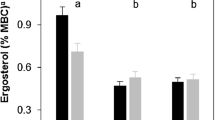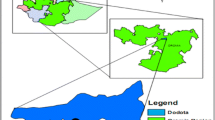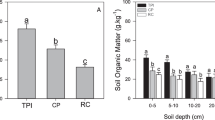Abstract
Aims
Despite many studies on the impact of arable land conversion to Short Rotation Coppice (SRC), few studies have been carried out on soil biota. This study aims at assessing biological and physico-chemical soil properties that are affected by SRC compared to forestry, grassland and an agrosystem.
Methods
All samples were collected in the Aisne valley (France), from the same type of soil, with four land uses, i.e. willow SRC, agrosystem, grassland and alluvial forest, 3 years after SRC was planted. We studied fertility, the biological community (earthworm diversity, density and biomass, bacterial and fungal density and community structures) and biochemical parameters (enzyme activities, basal respiration and nitrification).
Results
After 3 years’ growth, soil biological parameters (fungal abundance, laccase activity, anecic earthworm proportion and earthworm diversity) and CEC were higher in the SRC than in the agrosystem soil. In parallel, fungal abundance was higher in SRC than in forest and grassland soils.
Conclusion
Compared to annual arable crops, SRC promoted biological properties. However, in the short term, the parameters we measured were lower than in the forest and grassland soils. The use of certain parameters as indicators of soil functioning/quality assessment to discriminate the four land uses is discussed.




Similar content being viewed by others
References
Ananyeva ND, Susyan EA, Chernova OV et al (2006) The ratio of fungi and bacteria in the biomass of different types of soil determined by selective inhibition. Microbiology 75:702–707. doi:10.1134/S0026261706060130
Andrews S, Karlen D, Cambardella C (2004) The soil management assessment framework: a quantitative soil quality evaluation method. Soil Sci Soc Am J 68:1945–1962
Aon M, Colaneri A (2001) II. Temporal and spatial evolution of enzymatic activities and physico-chemical properties in an agricultural soil. Appl Soil Ecol 18:255–270. doi:10.1016/S0929-1393(01)00161-5
Bailey V, Smith J, Bolton H Jr (2002) Fungal-to-bacterial ratios in soils investigated for enhanced C sequestration. Soil Biol Biochem 34:997–1007. doi:10.1016/S0038-0717(02)00033-0
Baum C, Hrynkiewicz K, Leinweber P, Meißner R (2006) Heavy-metal mobilization and uptake by mycorrhizal and nonmycorrhizal willows (Salix × dasyclados). Z Pflanzenernähr Bodenk 169:516–522. doi:10.1002/jpln.200521925
Baum S, Weih M, Busch G et al (2009) The impact of Short Rotation Coppice plantations on phytodiversity. Landbauforsch Volk 59:163–170
Baum S, Bolte A, Weih M (2012a) Short Rotation Coppice (SRC) plantations provide additional habitats for vascular plant species in agricultural mosaic landscapes. Bioenerg Res 5:573–583. doi:10.1007/s12155-012-9195-1
Baum S, Bolte A, Weih M (2012b) High value of short rotation coppice plantations for phytodiversity in rural landscapes. Glob Chang Biol Bioenergy 4:728–738. doi:10.1111/j.1757-1707.2012.01162.x
Birkhofer K, Bezemer TM, Bloem J et al (2008) Long-term organic farming fosters below and aboveground biota: implications for soil quality, biological control and productivity. Soil Biol Biochem 40:2297–2308. doi:10.1016/j.soilbio.2008.05.007
Blouin M, Hodson ME, Delgado EA et al (2013) A review of earthworm impact on soil function and ecosystem services. Eur J Soil Sci 64:161–182. doi:10.1111/ejss.12025
Bonneau M, Souchier B (1994) Pédologie Tome 2: Constituants et propriétés du sol, Elsevier Masson
Bouché MB (1972) Lombriciens de France, Ecologie et systématique, I.N.R.A., Ann. zool. - écol. anim., numéro spécial
Brejda J, Moorman T, Karlen D, Dao T (2000) Identification of regional soil quality factors and indicators: I. Central and southern high plains. Soil Sci Soc Am J 64:2115–2124
Burns RG, Dick RP (2002) Enzymes in the environment. Activity, ecology and applications, Marcel Dekker Inc
Caldwell BA (2005) Enzyme activities as a component of soil biodiversity: a review. Pedobiologia 49:637–644. doi:10.1016/j.pedobi.2005.06.003
Carson JK, Gleeson DB, Clipson N, Murphy DV (2010) Afforestation alters community structure of soil fungi. Fungal Biol 114:580–584. doi:10.1016/j.funbio.2010.04.008
Carter M (2002) Soil quality for sustainable land management: organic matter and aggregation interactions that maintain soil functions. Agron J 94:38–47
Cébron A, Beguiristain T, Faure P et al (2009) Influence of vegetation on the in situ bacterial community and polycyclic aromatic hydrocarbon (PAH) degraders in aged PAH-contaminated or thermal-desorption-treated soil. Appl Biochem Microbiol 75:6322–6330. doi:10.1128/AEM.02862-08
Chaer G, Myrold D, Bottomley P (2009) A soil quality index based on the equilibrium between soil organic matter and biochemical properties of undisturbed coniferous forest soils of the Pacific Northwest. Soil Biol Biochem 41:822–830. doi:10.1016/j.soilbio.2009.02.005
Chan K (2001) An overview of some tillage impacts on earthworm population abundance and diversity — implications for functioning in soils. Soil Tillage Res 57:179–191. doi:10.1016/S0167-1987(00)00173-2
Chen CR, Condron LM, Davis MR, Sherlock RR (2000) Effects of afforestation on phosphorus dynamics and biological properties in a New Zealand grassland soil. Plant Soil 220:151–163. doi:10.1023/A:1004712401721
Chen CR, Condron LM, Xu ZH (2008) Impacts of grassland afforestation with coniferous trees on soil phosphorus dynamics and associated microbial processes: a review. For Ecol Manag 255:396–409. doi:10.1016/j.foreco.2007.10.040
Cluzeau D, Guernion M, Chaussod R et al (2012) Integration of biodiversity in soil quality monitoring: baselines for microbial and soil fauna parameters for different land-use types. Eur J Soil Biol 49:63–72. doi:10.1016/j.ejsobi.2011.11.003
Costa P, Souza-Motta C, Malosso E (2012) Diversity of filamentous fungi in different systems of land use. Agrofor Syst 85:195–203
Cuendet G (1995) Identification des lombriciens de Suisse. Vauderens 19p
Curry JP, Byrne D, Schmidt O (2002) Intensive cultivation can drastically reduce earthworm populations in arable land. Eur J Soil Biol 38:127–130. doi:10.1016/S1164-5563(02)01132-9
De Vries FT, Hoffland E, van Eekeren N et al (2006) Fungal/bacterial ratios in grasslands with contrasting nitrogen management. Soil Biol Biochem 38:2092–2103. doi:10.1016/j.soilbio.2006.01.008
De Vries FT, Bloem J, van Eekeren N et al (2007) Fungal biomass in pastures increases with age and reduced N input. Soil Biol Biochem 39:1620–1630. doi:10.1016/j.soilbio.2007.01.013
Dick RP, Breakwell DP, Turco RF (1996) Soil enzyme activities and biodiversity measurements as integrative microbiological indicators. In: Doran J, Jones A (eds) Methods for assessing soil quality. pp 247–271
Dimitriou I, Baum C, Baum S et al (2009) The impact of short rotation coppice (SRC) cultivation on the environment. Landbauforsch Volk 59:159
Edwards CA, Bohlen PJ (1996) Biology and Ecology of Earthworms Third edition, Chapman&Hall.
Ens J, Farrell R, Bélanger N (2013) Early effects of afforestation with willow (Salix purpurea, “Hotel”) on soil carbon and nutrient availability. Forest 137–154. doi: 10.3390/f4010137
Faasch RJ, Patenaude G (2012) The economics of short rotation coppice in Germany. Biomass Bioenergy 45:27–40. doi:10.1016/j.biombioe.2012.04.012
Failing L, Gregory R (2003) Ten common mistakes in designing biodiversity indicators for forest policy. J Environ Manag 68:121–132. doi:10.1016/S0301-4797(03)00014-8
Felske A, Akkermans A, De Vos W (1998) Quantification of 16S rRNAs in complex bacterial communities by multiple competitive reverse transcription PCR in temperature gradient gel electrophoresis fingerprints. Appl Environ Microbiol 64:4581–4587
Floch C, Alarcon-Gutiérrez E, Criquet S (2007) ABTS assay of phenol oxidase activity in soil. J Microbiol Meth 71:319–324. doi:10.1016/j.mimet.2007.09.020
Frey S, Elliott E, Paustian K (1999) Bacterial and fungal abundance and biomass in conventional and no-tillage agroecosystems along two climatic gradients. Soil Biol Biochem 31:573–585. doi:10.1016/S0038-0717(98)00161-8
Friis K, Reddersen J, Petersen J (1999) Planting SRC willow on arable fields: effects on earthworm fauna. 105:71–78
Green VS, Stott DE, Diack M (2006) Assay for fluorescein diacetate hydrolytic activity: optimization for soil samples. Soil Biol Biochem 38:693–701. doi:10.1016/j.soilbio.2005.06.020
Hailu A, Chambers R (2012) A Luenberger soil-quality indicator. J Prod Anal 38:145–154. doi:10.1007/s11123-011-0255-x
Harinikumar K, Bagyaraj D (1994) Potential of earthworms, ants, millipedes, and termites for dissemination of vesicular-arbuscular mycorrhizal fungi in soil. Biol Fertil Soils 18:115–118. doi:10.1007/BF00336456
Havlicek E (2012) Soil biodiversity and bioindication: from complex thinking to simple acting. Eur J Soil Biol 49:80–84. doi:10.1016/j.ejsobi.2012.01.009
Hill TCJ, Walsh KA, Harris JA, Moffett BF (2003) Using ecological diversity measures with bacterial communities. FEMS Microbiol Ecol 43:1–11. doi:10.1111/j.1574-6941.2003.tb01040.x
Insam H, Mitchell C, Dormaar J (1991) Relationship of soil microbial biomass and activity with fertilization practice and crop yield of three ultisols. Soil Biol Biochem 23:459–464
Jandl G, Baum C, Blumschein A, Leinweber P (2012) The impact of short rotation coppice on the concentrations of aliphatic soil lipids. Plant Soil 350:163–177. doi:10.1007/s11104-011-0892-x
Julkunen-Tiitto R (1985) Phenolic constituents in the leaves of northern willows: methods for the analysis of certain phenolics. J Agric Food Chem 33:213–217. doi:10.1021/jf00062a013
Karlen DL, Mausbach MJ, Doran JW et al (1997) Soil quality: a concept, definition, and framework for evaluation (a guest editorial). Soil Sci Soc Am J 61:4–10
Khasa PD, Chakravarty P, Robertson A et al (2002) The mycorrhizal status of selected poplar clones introduced in Alberta. Biomass Bioenergy 22:99–104. doi:10.1016/S0961-9534(01)00072-1
Lagerlöf J, Pålsson O, Arvidsson J (2011) Earthworms influenced by reduced tillage, conventional tillage and energy forest in Swedish agricultural field experiments. Acta Agric Scand Sect B Soil Plant Sci 62:235–244. doi:10.1080/09064710.2011.602717
Lavelle P, Spain A (2005) Soil ecology. Springer, Amsterdam
Ledin S (1998) Environmental consequences when growing short rotation forests in Sweden. Biomass Bioenergy 15:49–55. doi:10.1016/S0961-9534(97)10054-X
Liang C, da Jesus EC, Duncan DS et al (2012) Soil microbial communities under model biofuel cropping systems in southern Wisconsin, USA: impact of crop species and soil properties. Appl Soil Ecol 54:24–31. doi:10.1016/j.apsoil.2011.11.015
Lockwell J, Guidi W, Labrecque M (2012) Soil carbon sequestration potential of willows in short-rotation coppice established on abandoned farm lands. Plant Soil 360:299–318. doi:10.1007/s11104-012-1251-2
Lueders T, Wagner B, Claus P, Friedrich MW (1998) Stable isotope probing of rRNA and DNA reveals a dynamic methylotroph community and trophic interactions with fungi and protozoa in oxic rice field soil. Environ Microbiol 64:4581–4587. doi:10.1046/j.1462-2920.2003.00535.x
Makeschin F (1994) Effects of energy forestry on soils. Biomass Bioenergy 6:63–79
Marx M, Wood M, Jarvis S (2001) A microplate fluorimetric assay for the study of enzyme diversity in soils. Soil Biol Biochem 33:1633–1640. doi:10.1016/S0038-0717(01)00079-7
Muyzer G, Brinkhoff T, Nübel U et al (1998) Denaturing gradient gel electrophoresis (DGGE) in microbial ecology. Kluwer Academic Publishers, Dordrecht, pp 1–27
Oades J (1993) The role of biology in the formation, stabilization and degradation of soil structure. Geoderma 56:377–400
Peigne J, Cannavaciuolo M, Gautronneau Y et al (2009) Earthworm populations under different tillage systems in organic farming. Soil Tillage Res 104:207–214
Pérès G, Piron D, Bellido A, Cluzeau D (2008) Earthworms used as indicators of agricultural managements. Fresen Environ Bull 17:1181–1189
Pfiffner L, Luka H (2007) Earthworm populations in two low-input cereal farming systems. Appl Soil Ecol 37:184–191. doi:10.1016/j.apsoil.2007.06.005
Plassart P, Akpa Vinceslas M, Gangneux C et al (2008) Molecular and functional responses of soil microbial communities under grassland restoration. Agric Ecosyst Environ 127:286–293. doi:10.1016/j.agee.2008.04.008
Püttsepp Ü, Rosling A, Taylor A (2004) Ectomycorrhizal fungal communities associated with Salix viminalis L. and S. dasyclados Wimm. clones in a short-rotation forestry plantation. Forest Ecol Manag 196:413–424. doi:10.1016/j.foreco.2004.04.003
Ratcliff AW, Busse MD, Shestak CJ (2006) Changes in microbial community structure following herbicide (glyphosate) additions to forest soils. Appl Soil Ecol 34:114–124. doi:10.1016/j.apsoil.2006.03.002
Rezaei SA, Gilkes RJ, Andrews SS (2006) A minimum data set for assessing soil quality in rangelands. Geoderma 136:229–234. doi:10.1016/j.geoderma.2006.03.021
Robinson K, Karp A, Taylor G (2004) Defining leaf traits linked to yield in short-rotation coppice Salix. Biomass Bioenergy 26:417–431. doi:10.1016/j.biombioe.2003.08.012
Rossi J, Franc A, Rousseau G (2009) Indicating soil quality and the GISQ. Soil Biol Biochem 41:444–445. doi:10.1016/j.soilbio.2008.10.004
Rowe RL, Hanley ME, Goulson D et al (2011) Potential benefits of commercial willow Short Rotation Coppice (SRC) for farm-scale plant and invertebrate communities in the agri-environment. Biomass Bioenergy 35:325–336. doi:10.1016/j.biombioe.2010.08.046
Rytter R, Rytter L (1998) Growth, decay, and turnover rates of fine roots of basket willows. Can J For Res 28:893–902
Saha S, Prakash V, Kundu S et al (2008) Soil enzymatic activity as affected by long term application of farm yard manure and mineral fertilizer under a rainfed soybean–wheat system in N-W Himalaya. Eur J Soil Biol 44:309–315. doi:10.1016/j.ejsobi.2008.02.004
Scheu S, Parkinson D (1994) Changes in bacterial and fungal biomass C, bacterial and fungal biovolume and ergosterol content after drying, remoistening and incubation of different layers of cool temperate forest soils. Soil Biol Biochem 26:1515–1525
Schnurer J, Rosswall T (1982) Fluorescein diacetate hydrolysis as a measure of total microbial activity in soil and litter. Appl Environ Microbiol 43:1256–1261
Schoenholtz S, Miegroet H, Burger J (2000) A review of chemical and physical properties as indicators of forest soil quality: challenges and opportunities. Forest Ecol Manag 138:335–356. doi:10.1016/S0378-1127(00)00423-0
Schrader S, Zhang H (1997) Earthworm casting: stabilization or destabilization of soil structure? Soil Biol Biochem 29:469–475. doi:10.1016/S0038-0717(96)00103-4
Schulz U, Brauner O, Gruay H (2009) Animal diversity on short-rotation coppices - a review. Landbauforsch Volk 59(181):171
Simpson RT, Frey S, Six J, Thiet R (2004) Preferential accumulation of microbial carbon in aggregate structures of no-tillage soils. Soil Sci Soc Am J 68:1249–1255
Sinsabaugh RL, Lauber CL, Weintraub MN et al (2008) Stoichiometry of soil enzyme activity at global scale. Ecol Lett 11:1252–1264. doi:10.1111/j.1461-0248.2008.01245.x
Šlapokas T, Granhall U (1991) Decomposition of willow-leaf litter in a short-rotation forest in relation to fungal colonization and palatability for earthworms. Biol Fertil Soils 10:241–248. doi:10.1007/BF00337374
Stenberg B (1999) Monitoring soil quality of arable land: microbiological indicators. Acta Agric Scand Sect B Soil Plant Sci 49:1–24. doi:10.1080/09064719950135669
Suthar S (2009) Earthworm communities a bioindicator of arable land management practices: a case study in semiarid region of India. Ecol Indic 9:588–594. doi:10.1016/j.ecolind.2008.08.002
Thion C, Cébron A, Beguiristain T, Leyval C (2012) Long-term in situ dynamics of the fungal communities in a multi-contaminated soil are mainly driven by plants. FEMS Microbiol Ecol 82:169–181. doi:10.1111/j.1574-6941.2012.01414.x
Toljander Y, Weih M, Taylor A (2006) Mycorrhizal colonisation of willows in plantations and adjacent natural stands. Proceedings of the 5th International Conference on Mycorrhiza
Van der Heijden E (2001) Differential benefits of arbuscular mycorrhizal and ectomycorrhizal infection of Salix repens. Mycorrhiza 10:185–193. doi:10.1007/s005720000077
Velasquez E, Lavelle P, Andrade M (2007) GISQ, a multifunctional indicator of soil quality. Soil Biol Biochem 39:3066–3080. doi:10.1016/j.soilbio.2007.06.013
Wardle DA, Giller KE (1996) The quest for a contemporary ecological dimension to soil biology. Soil Biol Biochem 28:1549–1554. doi:10.1016/S0038-0717(96)00293-3
Wardle DA, Yeates GW, Watson RN, Nicholson KS (1993) Response of soil microbial biomass and plant litter decomposition to weed management strategies in maize and asparagus cropping systems. Soil Biol Biochem 25:857–868. doi:10.1016/0038-0717(93)90088-S
Whalen JK, Costa C (2003) Linking spatio-temporal dynamics of earthworm populations to nutrient cycling in temperate agricultural and forest ecosystems: the 7th international symposium on earthworm ecology · Cardiff · Wales · 2002. Pedobiologia 47:801–806. doi:10.1078/0031-4056-00262
Zaborski ER (2003) Allyl isothiocyanate: an alternative chemical expellant for sampling earthworms. Appl Soil Ecol 22:87–95. doi:10.1016/S0929-1393(02)00106-3
Acknowledgments
We thank Philippe Lucas, the owner of the SRC plot, Florent Germon from Luzéal Company and Antoine Dalle from Salix Energie for their help and collaboration in the field work. This project was supported by Kinomé company and ANRT (National Agency of Research and Technology) with a CIFRE (Industrial Convention of Research Formation) contract number 2009/13/07. ADEME («Agence de l’Environnement et de la Maîtrise de l’Energie») sponsored and supported the research (contract number 0975C0095).
Author information
Authors and Affiliations
Corresponding author
Additional information
Responsible Editor: Hans Lambers.
Rights and permissions
About this article
Cite this article
Stauffer, M., Leyval, C., Brun, JJ. et al. Effect of willow short rotation coppice on soil properties after three years of growth as compared to forest, grassland and arable land uses. Plant Soil 377, 423–438 (2014). https://doi.org/10.1007/s11104-013-1986-4
Received:
Accepted:
Published:
Issue Date:
DOI: https://doi.org/10.1007/s11104-013-1986-4




